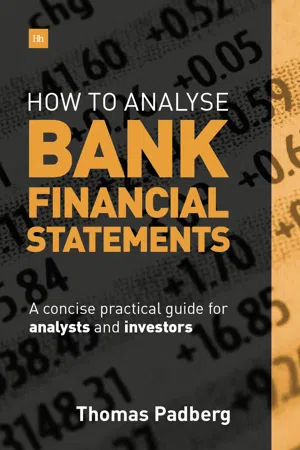
How to Analyse Bank Financial Statements
A concise practical guide for analysts and investors
- English
- ePUB (mobile friendly)
- Available on iOS & Android
How to Analyse Bank Financial Statements
A concise practical guide for analysts and investors
About this book
The financial statements of banks differ very much from those of non-banks. The assets and liabilities are mostly financial based, and the equity ratio is far lower than the equity ratios of industrial companies. Banking supervision has a big influence on the financial statements too. Recent years have shown the risks which can evolve from banks, but normal instruments of financial statement analysis are not sufficient to analyse banks and locate these risks: different methods are needed.This book, by experienced bank analyst Thomas Padberg, provides analysts and investors with the tools to analyse bank financial statements, find problems in bank finances, and assess the risks of banks. Examples with real bank financial data are used to show readers the step-by-step methods to follow when looking at bank financial statements.The book covers:- The specific accounting rules that apply to banks- How to analyse bank segment reporting- The ratios to use when analysing bank financial statements- How to analyse bank profit and loss accounts- Equity analysis and stock analysis of banksThis is an essential guide for all analysts and serious investors who need to analyse bank financial statements.
Frequently asked questions
- Essential is ideal for learners and professionals who enjoy exploring a wide range of subjects. Access the Essential Library with 800,000+ trusted titles and best-sellers across business, personal growth, and the humanities. Includes unlimited reading time and Standard Read Aloud voice.
- Complete: Perfect for advanced learners and researchers needing full, unrestricted access. Unlock 1.4M+ books across hundreds of subjects, including academic and specialized titles. The Complete Plan also includes advanced features like Premium Read Aloud and Research Assistant.
Please note we cannot support devices running on iOS 13 and Android 7 or earlier. Learn more about using the app.
Information
Table of contents
- Contents
- About the author
- Acknowledgements
- Preface
- 1. Introduction
- 2. Specifics of Bank Financial Statement Analysis
- 3. Accounting Rules for Banks
- 4. Analysis of Segment Reporting
- 5. Ratios for Bank Financial Statement Analysis
- 6. Analysis of the Profit and Loss Account
- 7. Equity Analysis
- 8. Stock Analysis
- 9. Conclusion